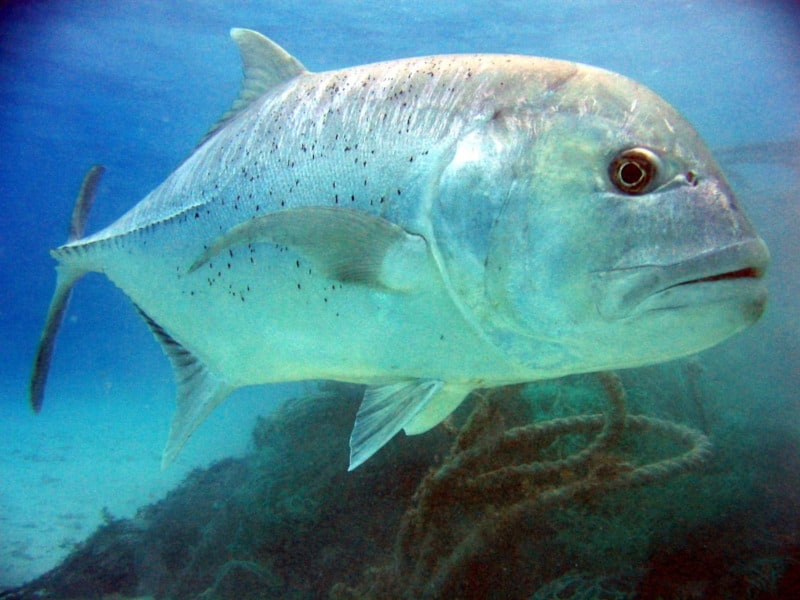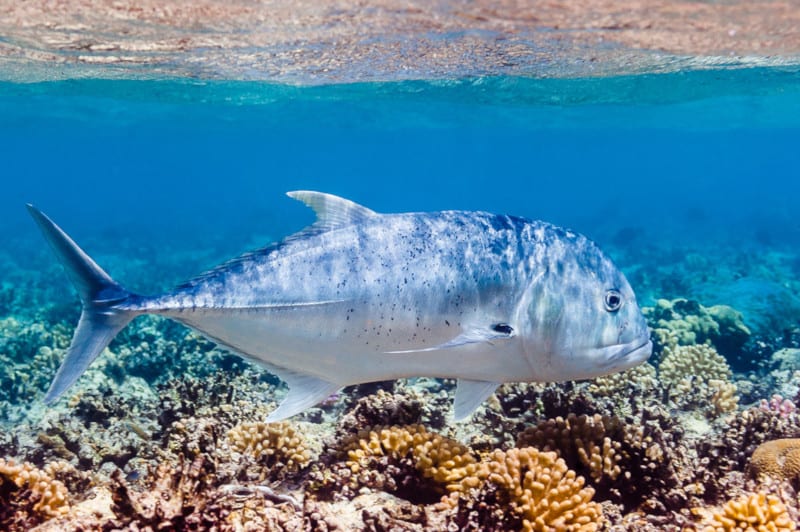
Giant Trevally Facts
- Perhaps most notably, one fact truly stands out from the others about the amazing Giant Trevally. That’s the relatively surprising fact that the impressive creature actually constitutes an apex predator in most of the regions it inhabits.
- The highly distinctive species holds this impressive status due to a combination of several fascinating factors. Firstly, in one part of its native habitat range, this fascinating fish has developed a remarkable behavioral trait.
- This holds true because the wonder of Nature frequently shadows the movements of certain seals. By doing this, the resourceful fish often catches prey preoccupied with escaping the seals. It literally lets the seals do its work for it.
- Secondly, the fish does not simply play it safe. In fact, this species also sometimes employs the same technique with various sharks. The amazing animal utilizes this highly evolved strategy both singly and working in groups, in coordination.
- Finally, it shows itself to have an incredible ability. Individuals in one specific part of its range use the most remarkable strategy of all. There, many individuals of the Giant Trevally prey on young terns, as they fall into the water while learning to fly.
Related Articles

Giant Trevally Physical Description
Quite clearly, the Giant Trevally lives up to the most often used common name. That holds true because the fascinating creature ranks as the largest species in its genus. Most related species remain much smaller in terms of length and weight.
Most notably, rare individuals sometimes measure up to as much as a truly astonishing 5.57 ft (1.7 m) in length. Some specimens also weigh as much as an astounding 176 lb (80 kg). Most individuals, however, rarely exceed lengths of more than 31.5 in (80 cm).
The body of this animal also typically has an impressively elongated shape. It also displays an ovate body, with a marginally compressed form. These facts, therefore, make the overall appearance of the creature remarkably similar to related species.
But, unlike some species, the Giant Trevally does not display any degree of sexual dimorphism. In both genders, the coloring is a silvery-gray. Yet older individuals often turn almost completely black. The upper body and head often appear darker in both sexes.
- Kingdom: Animalia
- Phylum: Chordata
- Class: Actinopterygii
- Order: Perciformes
- Family: Carangidae
- Genus: Caranx
Giant Trevally Distribution, Habitat, and Ecology
Quite fortunately, the marvelous Giant Trevally has a comparatively wide distribution range. To be more precise, it inhabits specific sections of both the Pacific and Indian Oceans. This substantial range further extends along the coasts of three continents.
But within than range, this impressive species only inhabits tropical and subtropical waters. However, that area also includes hundreds of islands and archipelagos of all sizes. Some of these even include Madagascar and the Maldives.
Its versatility, though, is not merely limited to its geographical range. That’s because it also thrives in a wide range of both inshore and offshore marine environments. The awesome Giant Trevally even sometimes appears in places like estuaries and rivers.
Finally, its feeding patterns understandably vary from region to region, and its diet does also. But, the majority of its prey includes fish, cephalopods, crustaceans, mollusks. Yet, its appetite even extends to birds in one part of its range.
Species Sharing Its Range
Check out our other articles on 7 Stunning European Flowering Plants, Golden Armadillo Lizard, Kali Gandaki Gorge, Vietnamese Mossy Frog, Giant Golden Orb Weaver, Indian Vulture
